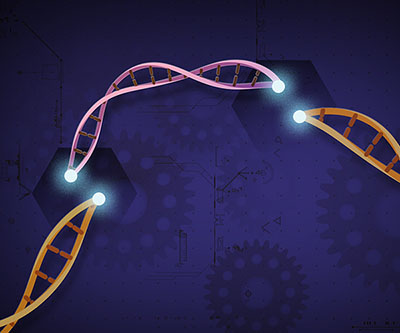
CRISPR-Cas9 is a customizable tool that lets scientists cut and insert small pieces of DNA at precise areas along a DNA strand.
Credit: Ernesto del Aguila III, NHGRI.
People with the rare inherited disorder glycogen storage disease type-Ia (GSD-Ia) have a deficiency in glucose-6-phosphatase-α, the enzyme that enables the body to break down complex molecules to produce the simple sugar glucose. People with GSD-Ia cannot produce glucose to supply energy and maintain steady blood sugar levels. Without dietary therapies to stabilize blood sugar levels, GSD-Ia can be lethal soon after birth. However, such therapies do not correct the underlying disease processes.
Previous preclinical studies by the Chou Lab contributed to the development of a potential gene augmentation therapy for GSD-Ia that is now being evaluated in a late-stage clinical trial. The therapy uses a harmless virus to deliver healthy copies of the G6PC gene that produces glucose-6-phosphatase-α. The earlier in life the therapy is delivered, the more effective it may be. However, because the liver grows rapidly during childhood, the gene augmentation therapy may be diluted out with age and may not last a lifetime.
As a more permanent alternative therapy, the Chou Lab is exploring genome editing. This approach aims to correct the variations in G6PC that cause GSD-Ia. The researchers are leveraging CRISPR/Cas9—a strategy that edits genes by precisely cutting DNA and then letting natural DNA repair processes take over, analogous to how a mistake in an electronic document can be removed by deleting the error and inserting a correction. Their approach uses a DNA repair process that is effective in both dividing and nondividing cells and employs lipid nanoparticles—small particles comprising a mixture of fats and the gene-editing tools—to deliver the therapy into cells, a method that reduces potential risks related to viral delivery of editing reagents.
The researchers delivered one or two doses of the gene-editing treatment to mice carrying a diseased G6PC gene. While untreated GSD-Ia mice do not survive past 6 weeks of age, 86% of GSD-Ia mice treated with one dose survived at least 8 weeks, and all mice treated with two doses survived at least 16 weeks. The treatment restored glucose-6-phosphatase-α function to about 4% of its typical activity—levels previously established to be therapeutic. None of the treated mice required dietary therapy for the 16 weeks of the study.
The findings suggest that the gene-editing strategy may offer a permanent correction of the G6PC gene without the possible complications of using a viral delivery system. The researchers are currently working to improve the efficiency of gene editing and further evaluate its safety, with the future goal of testing an updated strategy in people.
NICHD co-authors of the paper include Ananya Samanta, Nelson George, Irina Arnaoutova, Hung-Dar Chen, and Brian C. Mansfield.
Learn more about the Developmental Endocrinology, Metabolism, Genetics and Endocrine Oncology group: https://www.nichd.nih.gov/about/org/dir/affinity-groups/DEMG-EO
 BACK TO TOP
BACK TO TOP